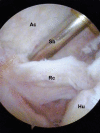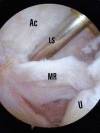Captured Rotator Cuff: A Poor Prognostic Factor in Rotator Cuff Repair
- PMID: 33627905
- PMCID: PMC7895633
- DOI: 10.1055/s-0040-1702963
Captured Rotator Cuff: A Poor Prognostic Factor in Rotator Cuff Repair
Abstract
Objective To describe a new presentation of tears and retears of the rotator cuff, which we denominate captured rotator cuff (CRC). We also aim to evaluate it clinically and through images. Methods We assessed retrospectively 16 patients with intraoperative diagnosis of CRC between March 2005 and September 2017; by means of imaging (radiography and magnetic resonance imaging [MRI]) and functional scores (UCLA and Constant & Murley). In images we analyzed the evolution for rotator cuff arthropathy and presence of retears. Functionally, we compared the affected side with the contralateral side and extensive lesions with nonextensive. Results Five (31.25%) patients presented with rotator cuff arthropathy, and 10 (62.5%) with retears. Three (75%) patients with nonextensive lesions had good/excellent UCLA and Constant & Murley scores. In patients with extensive lesions, when the Constant & Murley score was evaluated, 6 (50%) presented good/excellent results, and in the UCLA score, 7 (58.3%). Comparing the affected side (Constant 74.72 points; UCLA 20 points) with the contralateral side (Constant 96.96 points; UCLA 25.63 points), there were worse functional results with statistical significance. Conclusion The diagnosis of CRC is suspected by characteristic findings on MRI and confirmed in arthroscopy. The affected shoulders present worse functional postoperative scores.
Keywords: rotator cuff; rupture; shoulder; subacromial adhesions.
Sociedade Brasileira de Ortopedia e Traumatologia. This is an open access article published by Thieme under the terms of the Creative Commons Attribution-NonDerivative-NonCommercial License, permitting copying and reproduction so long as the original work is given appropriate credit. Contents may not be used for commercial purposes, or adapted, remixed, transformed or built upon. ( https://creativecommons.org/licenses/by-nc-nd/4.0/ ).
Conflict of interest statement
Conflito de Interesses Os autores declaram não haver conflito de interesses.
Figures












Similar articles
-
[Comparison of therapeutic effects of three repair methods for rotator cuff tears under arthroscopy].Zhongguo Gu Shang. 2017 Aug 25;30(8):689-694. doi: 10.3969/j.issn.1003-0034.2017.08.002. Zhongguo Gu Shang. 2017. PMID: 29455496 Chinese.
-
EVALUATION OF ANATOMICAL INTEGRITY USING ULTRASOUND EXAMINATION, AND FUNCTIONAL INTEGRITY USING THE CONSTANT & MURLEY SCORE, OF THE ROTATOR CUFF FOLLOWING ARTHROSCOPIC REPAIR.Rev Bras Ortop. 2015 Nov 16;45(2):174-80. doi: 10.1016/S2255-4971(15)30289-5. eCollection 2010 Mar-Apr. Rev Bras Ortop. 2015. PMID: 27022538 Free PMC article.
-
Repair integrity and functional outcomes for arthroscopic margin convergence of rotator cuff tears.J Bone Joint Surg Am. 2013 Mar 20;95(6):536-41. doi: 10.2106/JBJS.L.00397. J Bone Joint Surg Am. 2013. PMID: 23515988
-
Arthroscopic repair of full-thickness tears of the rotator cuff: 2- to 14-year follow-up.Arthroscopy. 2002 Feb;18(2):136-44. doi: 10.1053/jars.2002.30443. Arthroscopy. 2002. PMID: 11830806 Clinical Trial.
-
Are platelet concentrates an ideal biomaterial for arthroscopic rotator cuff repair? A meta-analysis of randomized controlled trials.Arthroscopy. 2014 Nov;30(11):1483-90. doi: 10.1016/j.arthro.2014.03.020. Epub 2014 Jun 6. Arthroscopy. 2014. PMID: 24913394 Review.
Cited by
-
EVALUATION OF TENDON HEALING AFTER ARTHROSCOPIC REPAIR OF ISOLATED SUPRASPINATUS TEARS.Acta Ortop Bras. 2025 Jun 2;33(2):e285693. doi: 10.1590/1413-785220253302e285693. eCollection 2025. Acta Ortop Bras. 2025. PMID: 40475366 Free PMC article.
-
Re-tear after arthroscopic rotator cuff repair can be predicted using deep learning algorithm.Front Artif Intell. 2024 Feb 29;7:1331853. doi: 10.3389/frai.2024.1331853. eCollection 2024. Front Artif Intell. 2024. PMID: 38487743 Free PMC article.
-
Arthroscopic Acromiograft for Large-to-Massive Rotator Cuff Tears: A Rescue Technique for Restoring Shoulder Stability.Arthrosc Tech. 2022 Sep 17;11(10):e1729-e1735. doi: 10.1016/j.eats.2022.06.008. eCollection 2022 Oct. Arthrosc Tech. 2022. PMID: 36311319 Free PMC article.
References
-
- Chen A L, Mears S C, Hawkins R J. Orthopaedic care of the aging athlete. J Am Acad Orthop Surg. 2005;13(06):407–416. - PubMed
-
- Codman E A. Boston: Thomas Todd; 1934. Rupture of the supraspinatus tendon and other lesions in or about the subacromial bursa. The shoulder.
-
- Brislin KJ, Field LD, Savoie FH 3rd. Complications after arthros- copic rotator cuff repair. Arthroscopy 2007;23(02):124–128 - PubMed
-
- Huberty D P, Schoolfield J D, Brady P C, Vadala A P, Arrigoni P, Burkhart S S. Incidence and treatment of postoperative stiffness following arthroscopic rotator cuff repair. Arthroscopy. 2009;25(08):880–890. - PubMed
-
- Paxton E S, Teefey S A, Dahiya N, Keener J D, Yamaguchi K, Galatz L M. Clinical and radiographic outcomes of failed repairs of large or massive rotator cuff tears: minimum ten-year follow-up. J Bone Joint Surg Am. 2013;95(07):627–632. - PubMed
LinkOut - more resources
Full Text Sources

